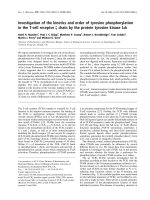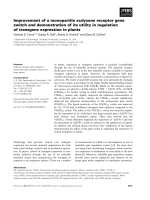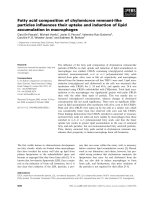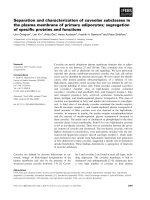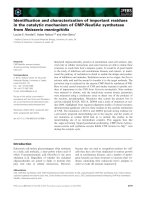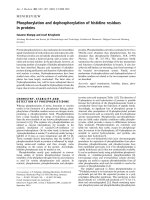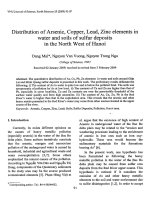Power and politics of battlefield tourism in kinmen, taiwan
Bạn đang xem bản rút gọn của tài liệu. Xem và tải ngay bản đầy đủ của tài liệu tại đây (3.26 MB, 180 trang )
TOURISM-MENTALITY:
POWER AND POLITICS OF BATTLEFIELD TOURISM
IN KINMEN, TAIWAN
ZHANG JIAJIE
NATIONAL UNIVERSITY OF SINGAPORE
2009
TOURISM-MENTALITY:
POWER AND POLITICS OF BATTLEFIELD TOURISM
IN KINMEN, TAIWAN
ZHANG JIAJIE
(B. Soc. Sci. (Hons.)), NUS
A THESIS SUBMITTED FOR
THE DEGREE OF MASTER OF SOCIAL SCIENCES
DEPARTMENT OF GEOGRAPHY
NATIONAL UNIVERSITY OF SINGAPORE
2009
ACKNOWLEDGEMENTS
Randy Pausch in his much celebrated book, “The Last Lecture”, advised his reader
that, "Brick walls are there for a reason: they let us prove how badly we want certain
things." Brick walls are however, not overcome alone. I am grateful to those who
have in one way or another assisted me in overcoming the multiple challenges in the
course of completing this thesis.
My utmost gratitude goes to my supervisor, A/P T.C. Chang. Thank you for
your magnanimous guidance and kind understanding throughout my graduate years. I
have benefitted immensely from your supervision and mentorship, be it in research or
teaching.
The Department of Geography has been (and still is) a great place to be. I am
thankful to the wonderful people who have shown interest in my research topic and
helped shape what follows in this thesis, but who are not to be blamed for it. They
include Dr. C.P. Pow, Dr. Noorashikin, A/P Tim Bunnell, A/P Shirlena Huang and
Professor Henry Yeung. I remain especially appreciative to A/Ps Peggy Teo and
Victor Savage, who have always been so supportive and candid.
The two-year stint as a graduate student would not have been so smoothsailing without the support rendered by staff members in the department. I sincerely
thank Ms. Pauline Lee for her professionalism in helping me deal with all sorts of
administrative matters. I also owe the beautifully crafted maps to Mrs. Lee Li
Kheng’s excellent cartographic work. Financial assistance from the Faculty of Arts
and Social Sciences Graduate Research Support Scheme is gratefully acknowledged.
My fieldwork in Kinmen was successful due to the enthusiastic participation
of my respondents. Special thanks to my interviewees from the Kinmen County
Government: Mr. Lin Chen-Cha, Mr. Chen Chao-Jin, Mr. Li Zai-Hang, and Ms. Cung
Meng-Chi; from the Kinmen National Park: Ms. Huang Tzu-Chuan, Mr. Su ChengChi, and Ms. Li Ming-Yi; and from the Institute for Physical Planning & Information:
Ms. Carol Y. Lin.
Not forgetting my interviewees from the private sector for sharing their
thoughts with me: Mr. Li Min-De from Bar Sa Restaurant, Mr. Chen Chin-Fu from
Min-Jih Gong Tang, Ms. Chen Li-Lin from Yi Lai Shuen, Mr. Wu Tseng-Dong from
Chin Ho Li Knife, Mr. Lin Yong-Biao from Chang Ling Travel Agency, Ms. Gao
Shu-Zhen from Kinma Travel Service, and Mr. Chen Ho-Hai from Golden Universal
Travel Service.
The Kinmen locals were splendid informants. Thank you for considering me
as a fellow Kinmenese throughout my stay in Kinmen. Our ingenuous conversations
have contributed significantly to the analytical vigour of this research. My earnest
thanks go to Sheu Yen-Hsueh, Lee Chiung-Fang, He Ying-Cyuan, Yu-Zi, Jing-Yi,
Hui-Hsin, Miao-Chen, Lin Cheng-Shih, Shu-Yi, Rui-Yi, Wan-Ling and Yi-Jie for
providing timely assistance during and after my fieldwork in Kinmen.
i
It is my privilege to meet renowned scholars in the course of my academic
journey. They include A/P Chiang Bo-Wei from National Kinmen Institute of
Technology, A/P Michael Szonyi from Harvard University and Professor Wang
Gungwu from East Asia Institute, National University of Singapore. Your affirmation
and stimulating inputs have been a great source of motivation.
Graduate life would have been much less interesting without the company of
fellow geography enthusiasts, both local and international, past and present. I thank Li
Na, Fred, Sarah Moser, Kanchan, Diganta, Chen Rui, Liu Yi and Kanhaiya, for
creating such a friendly and warm environment. Our chatting sessions and moments
of joy in the graduate room would be fondly remembered. I am grateful to Chen Rui
for the Chinese translation of my interview questions.
Fieldwork is fun, but thesis writing is a chore. I thank Alvin Sim, Choon Hon,
Gladys, Jacqueline and Wanying for cheering me on right from the start. Your
encouragement and support have made this process less painful.
To my best friend Jianhong, thank you for always being there for me, both in
times of happiness and sorrow.
I was able to taste the intimate slices of life during my stay with relatives in
Taipei and Kinmen. This has contributed significantly to the smooth progress of my
overseas fieldwork.
I am hugely indebted to my mother and family members for their unfailing
love and support. Words alone cannot express my gratitude and appreciation towards
each of you.
Last but not least, I extend my heartfelt gratitude to those whom I have
inadvertently missed. Thank you!
This thesis is dedicated to the loving memory of my late grandfather, Teo Chew Hock.
Zhang Jiajie
August 2009
ii
TABLE OF CONTENTS
Page
Acknowledgements
i
Abstract
vi
List of Tables
vii
List of Figures
vii
List of Plates
vii
List of Abbreviations
ix
Romanisation of Chinese Words
x
Chapter One
Introduction
1.1
The Beginning of an Era of Peace & Co-Prosperity
1
1.2
Kinmen in Context: From Battlefield to Tourist Destination
4
1.3
Research Objectives and Argument
6
1.4
Key Concepts
8
1.4.1
1.4.2
1.4.3
8
11
15
1.5
Chapter Two
Governmentality
Landscape
Tourism-mentality
Thesis Organisation
15
Literature Review
2.1
Politics and Power in Tourism
17
2.2
Macro-politics and Tourism
20
2.3
Ideology and Hegemony
25
2.4
Micro-politics: A View ‘From Below’
28
iii
2.5
Heritage Tourism Politics: Ideological Framing of the Past?
32
2.6
Politics of Battlefield Tourism
36
2.7
Academic Literature on Kinmen’s Tourism
39
2.8
Conclusion: Towards a More Comprehensive Approach in
Understanding Tourism Politics
40
Chapter Three
Research Methodology
3.1
Introduction
42
3.2
Data Collection
42
3.2.1
3.2.2
3.2.3
42
45
46
Semi-structured in-depth interviews
Participant observation
Secondary data
3.3
Fieldwork as a Social Process: Experiences and Reflections
46
3.4
Conclusion
50
Chapter Four
From Policies to Programmes: The Government
of Kinmen’s Battlefield (Tourism) Landscape
4.1
Introduction
51
4.2
From Disciplinary Power to Governmental Technologies
52
4.2.1
4.2.2
52
58
Domination & Coercion Phase (1949-1992)
Post-conflict tourism & reconciliation
mentality phase (1992-present)
4.3
Tourism-mentalising Battlefield Kinmen:
The Heterogeneous State
61
4.4
Realigning the Battlefield Past
65
4.5
Reinforcing the Peace and Co-prosperity Agenda
82
4.6
Conclusion
91
iv
Chapter Five
Effects of Tourism-mentalisation: Local Entrepreneurs
& Ordinary Kinmen People as Tourism Subjects
5.1
Introduction
94
5.2
Place Branding & the Branding of Kinmen
96
5.3
Of Kaoliang, Bullets, Mines and Knives:
Local Entrepreneurs as Branding Agents
100
5.3.1
5.3.2
5.3.3
5.3.4
5.3.5
101
104
108
110
113
The Kinmen Kaoliang Liquor
The Kinmen Battlefield Cocktail Series
The Kinmen Peanut Candy
The Battlefield Mines Biscuit
The Kinmen Steel Knife
5.4
Allies of the State – Ordinary Kinmen People
as Tourism Subjects
116
5.5
Discussion
128
5.6
Conclusion
133
Chapter Six
Conclusion
6.1
Summary of Findings
135
6.2
Potentials for Future Research
138
6.3
Concluding Remarks: Sustaining the Peace
& Co-Prosperity Agenda
139
References
144
Appendices
160
v
ABSTRACT
The political dimensions of tourism have been traditionally studied through binary
understandings of ‘top-down vs bottom-up’ approaches, ‘hegemony vs resistance’,
‘winners vs losers’ etc. This thesis aims to go beyond binary understandings and reconceptualise the notion of ‘power’ in the discussion of tourism politics. By
synergising analytical tools from Foucault’s ‘governmentality’ and the concept of
‘landscape’ in cultural geography, this exploratory research introduces the analytics of
‘tourism-mentality’ in explicating the power and politics inherent in the government
of Kinmen’s battlefield tourism landscape. More specifically, three main locales of
power practices are discussed. First, ‘technologies of government’ utilised by the
tourism planners (i.e. Kinmen National Park and the county government) in their
attempt to convey both nationalist ideologies and post-war reconciliation mentality
through the promotion of battlefield tourism are unravelled. Second, the ways in
which such technologies are in turn incorporated or negotiated by the local
entrepreneurs in their day to day operations are analysed. Third, ordinary Kinmen
people’s conduct of citizenship in terms of their attitude and behaviour towards
Kinmen’s battlefield heritage are explicated. Discussion highlights the importance of
seeing power as horizontally distributed in the government of Kinmen’s battlefield
landscape in order to fully appreciate its tourism politics. Kinmen remains a symbolic
if not critical element in the delicate balance between fostering warmer ties with
China and Taiwan’s long-standing claim to sovereignty in this post-conflict era of
peace and co-prosperity.
Keywords:
battlefield,
tourism
politics,
tourism-mentality,
governmentality,
landscape, non-representational theory, Kinmen, Taiwan.
vi
LIST OF TABLES
Page
4.1
Assignment teams in a combat village
54
LIST OF FIGURES
1.1
Location of Kinmen
2
4.1
Map of attractions mentioned in thesis
66
LIST OF PLATES
4.1
Sending of hot air balloons (left) and broadcasting of propaganda
via 24,000-watt loudspeakers
57
4.2
Façade of Guningtou Battle Museum
67
4.3
One of 13 murals on display
68
4.4
The hero – Colonel Lee Kuang-Chien
69
4.5
Mural on the surrender of the People’s Liberation Army
69
4.6
Wax figures “manning” various weapons at the Rushan Old Barrack
72
4.7
A visitor interacting with the wax figures
73
4.8
Zhaishan Underground Tunnel
75
4.9
Military structures, monuments and statues at various round-abouts
79
4.10
Wall inscriptions on civilian houses
80
4.11
Art pieces on display at the Bunker Museum of Contemporary Art
84
vii
4.12
A myriad of activities at the Peace.Love Fair
86
4.13
Examples of cultural technologies of government
89
5.1
Commemorative Kaoliang liquor in various shapes
102
5.2
Menu showing the Kinmen Battlefield Cocktail Series
and the ‘Kuningtou Battle’ cocktail
104
5.3
“Bullet” Crackers
109
5.4
Battlefield Mines Biscuits
110
5.5
Souvenir military vehicles and figurines
113
5.6
The Kinmen steel knife made from artillery shells
114
5.7
A new generation of Chin Ho Li souvenir knives
115
5.8
Façade of the Qionglin Tunnel
and a narrow passage way inside the tunnel
122
5.9
“Brief Introduction of Qionglin Combat Village”
and military slogans found at an underground military command post
123
5.10
Pubian Village Air Raid Shelter Exhibition
125
5.11
Battlefield heritage in Pubian Village pointed out by Mr. He
126
viii
LIST OF ABBREVIATIONS
BMoCA
Bunker Museum of Contemporary Art
CCP
Chinese Communist Party
CNN
Cable News Network, US
CWAAQ
Council for War Area Administration in Quemoy
DPP
Democratic Progressive Party
IPPI
Institute for Physical Planning and Information
KMNP
Kinmen National Park
KMT
Kuomintang
NHK
Nippon Hoso Kyokai (Japan Broadcasting Corporation)
PLA
People’s Liberation Army
PRC
People’s Republic of China
QDC
Quemoy Defence Command
ROC
Republic of China
US
United States
ix
ROMANISATION OF CHINESE WORDS
Names of all tourist attractions mentioned in this thesis are romanised
according to the Hanyu Pinyin system. However, I choose to use ‘Kinmen’ instead of
its Hanyu Pinyin equivalent, ‘Jinmen’, as the former is a romanisation according to
the pronunciation of the local dialect and is the official name used by the state. The
island is also popularly referred to as ‘Quemoy’ in the western context.
x
CHAPTER ONE
INTRODUCTION
1.1
The Beginning of an Era of Peace & Co-Prosperity
4 July 2008 marks a historic moment in cross-strait relations between China and
Taiwan. For the first time in almost six decades, mainland Chinese were permitted to
visit Taiwan via direct charter flights. Under the agreement signed by the Association
for Relations Across the Taiwan Straits based in China, and the Taiwan-based Straits
Exchange Foundation, there is no need to travel to a third country 1 before landing.
Evidently, such a development goes in tandem with Taiwan President Ma Ying-jeou’s
doctrine of “Economic Cooperation Before Politics”. The landslide victory of
Taiwan’s Nationalist party, Kuomintang (KMT), in the parliamentary election and Ma
Ying-jeou winning the presidential election, 2 paved the way for improvement of
cross-strait ties, which were dampened significantly by the pro-independence stance
adopted by the previous administration. Head of China's Tourism Administration,
Shao Qi Wei, lauded the normalisation of travel between the two politically divided
territories, hailing the launch of regular commercial flights and the beginning of mass
tourism from China as akin to building “a bridge of friendship” (Morning Star Online,
4 July 2008). The opening of Taiwan to Chinese tourists is indeed as much an
economic decision as it is a political manoeuvre. Such a gesture of political goodwill
was reciprocated and extended further when in September of the same year, Wang Yi,
director of Beijing's State Council Taiwan Affairs Office, announced, amongst a slew
of incentives to boost tourism exchanges, that on top of weekend direct flights,
1
Tourists from China have to travel via a third country, for example, Hong Kong, before touching
down at their destination, Taiwan.
2
The KMT won 81 of the 113 seats in the parliamentary election in January 2008 and Ma won the
presidential election in March of the same year.
1
residents from thirteen provinces and cities in China 3 will be allowed to travel daily to
and from Taiwan via the Taiwan-held islands of Kinmen, Ma-tsu and Peng-hu
(Central News Agency, 8 September 2008) (see Figure 1.1).
Figure 1.1 Location of Kinmen
Such an arrangement brings the three offshore islands of Taiwan into the limelight in terms of tourism development. Of the three islands highlighted, Kinmen
possesses the best potential to be developed into a successful destination and point of
transit for tourists travelling between China and mainland Taiwan. Its geographical
proximity to the port city of Xiamen on mainland China defines its technical
advantage over Ma-tsu and Peng-hu. Infrastructure built for the existing ferry service
3
The 13 administrative districts are Liaoning, Jiangsu, Zhejiang, Fujian, Shangdong, Hubei,
Guangdong, Yunnan and Shaanxi provinces and the cities of Beijing, Tianjin, Shanghai and Chongqing
(Central News Agency English News, 7 September 2008).
2
between Xiamen and Kinmen under the “mini three links” 4 agreement can be readily
tapped on. Tourists from China entering Taiwan via Kinmen (and vice versa) can thus
save significantly on travel cost.
As a student researcher fascinated by Kinmen’s battlefield past, such political
underpinnings to its tourism development serve as a context for a more nuanced
understanding of cultural politics behind the production and consumption of the
(battlefield) tourism landscape. Kinmen’s identity as a former battlefield presents both
challenges and opportunities in positioning and branding it as a tourist destination.
The meaning of its battlefield identity becomes significant in an era of mutual
economic benefit and peaceful reconciliation between China and Taiwan. Preliminary
observation in my Honours thesis shows that both nationalist ideologies and post-war
reconciliation mentality co-exist to form the geopolitical intricacies behind the
presentation and re-presentation of Kinmen’s battlefield heritage (Zhang, 2007). The
strategies adopted by the state to convey these messages, and the underlying power
relationship remain to be discussed. To do this, there is a need to rethink the politics
of battlefield tourism in Kinmen. This thesis thus goes further to explore how the
Kinmen locals are convinced into accepting these ideologies, and how some have
become battlefield tourism subjects as their attitude and behaviour echo government’s
initiatives and ideologies.
4
The three links refer to economic and social links for direct trade, postal and shipping between
Kinmen and Ma-tsu of Taiwan, and Xiamen and Fuzhou of PRC (The Economist, 6 January 2001). The
‘mini three links’ was an experimental scheme to boost cross-strait ties prior to current developments.
3
1.2
Kinmen in Context: From Battlefield to Tourist Destination
Before explicating the objectives of this thesis, let me foreground the historical events
that form the basis of Kinmen’s battlefield identity. Covering an area of 150km2 and a
population of 72,000, Kinmen 5 is located 350km southwest of Taipei, Taiwan, but a
mere 8km from the city of Xiamen in the People’s Republic of China (PRC). The
island became a military stronghold of the Kuomintang’s (KMT) Nationalist Army
after its forces retreated from mainland China during the Civil War with the Chinese
Communist Party’s (CCP) People’s Liberation Army (PLA) in 1949. Kinmen,
together with Ma-tsu and a number of other off-shore islands were intended to be
“stepping stones” for Chiang Kai-shek’s forces to reclaim mainland China.
Initial attempts by the communists to capture Kinmen were thwarted by
KMT’s victory in the Guningtou Battle on Kinmen in late 1949. The onset of the
global Cold War and the American doctrine of containment further acted as
deterrence to the communist’s plans for invasion. However, the First and Second
Straits Crisis in 1954 and 1958 respectively, saw the PRC engaging Kinmen in fierce
artillery battles. Intervention by the United States (US) denied the prospect of a takeover. Therefore, the status of Kinmen had and still has symbolic meaning for Taiwan
in the wider geopolitical context. The involvement of the US in the prevention of a
CCP take-over testifies to the importance of the island’s strategic position as a bastion
against communist threat.
5
Kinmen is an archipelago consisting of 12 islands. This thesis focuses on the 2 main islands, namely
‘Big Kinmen’ and ‘Little Kinmen’. Unless otherwise stated, ‘Kinmen’ refers to both islands.
4
As a result of these events, Kinmen became a highly militarised area.
Fortresses, pillboxes and underground tunnels burgeoned and as much as one-third of
Taiwan’s total army was stationed on the island, outnumbering the local population of
60,000 (Szonyi, 2005). 6 Apart from the conscripted soldiers, a militia system had also
been set up whereby civilian villages were transformed into ‘combat villages’ (Chi,
2004). In 1956, the KMT government introduced the “Experimental Scheme of War
Area Administration on Kinmen and Ma-tsu”, which subjected the islands to absolute
military control (Jinmen xianzhi, 1992, cited in Chi, 2004). In Kinmen, the troops
were the main consumer base that sustained the local economy until 1992 when
tourism became increasingly important.
Several reasons explain why people are attracted to Kinmen. As the battlefront
of conflicts between PRC and Taiwan, Kinmen was inaccessible until 1992. The
curious want to see it for themselves, what Kinmen is really like. Retired soldiers who
have once served on the island have returned to reminisce the past and more
importantly, seek closure, usually in the company of family members. After the
establishment of the ‘mini three links’, ferry services between Xiamen and Kinmen
became available, and tourists from the PRC are keen to explore the mysterious
military bastion that the PLA surprisingly failed to capture in the past. Finally,
Kinmen’s new role as a gateway to Taiwan will be crucial in sustaining the island’s
tourism receipts. The battlefield landscape that represented a bastion of military might
and symbol of war was transformed almost overnight into a tourism landscape of
appeal for tourist consumption. Moreover, Kinmen’s battlefield identity is continually
being politicised in the midst of recent cross-strait relations. Therefore, it is the
6
Although the garrison size was never disclosed, it is estimated at 100,000.
5
battlefield tourism landscape that this timely thesis contextualises its analyses. In
short, tourism is seen not only as an important economic activity but a necessary
diplomatic tool since the de-militarisation of Kinmen. Therefore it is timely to
examine the politics of space and the power relations underlying the battlefield
landscape as this island is being transformed into a tourist destination.
Questions pertaining to ‘government’ (Foucault, 1991) arise: What are the
strategies adopted by the state to convince the Kinmen people that battlefield tourism
is appropriate or beneficial? Is there outright domination, as seen during the martial
law period, or is there room for subjectivities and negotiations? How does this
development trajectory play out at the different sectors of society, namely the public
(central and county government), the private (local entrepreneurs), and the people
(tourists and locals)? How are macro- and micro-politics enmeshed in the battlefield
tourism landscape? These preliminary questions serve as an overture to the next
section where I present the research objectives and argument of this thesis.
1.3
Research Objectives and Argument
This thesis aims to fulfil both conceptual and empirical objectives while remaining
policy-relevant. Firstly, I discuss the politics of Kinmen’s battlefield tourism using the
concept of ‘governmentality’ (Foucault, 1991), and applying both interpretative (i.e.
landscape as texts) and non-representational readings (landscape effects) of
‘landscape’ in the so-called ‘new cultural geography’. I posit that a synergy of these
analytical tools is necessary for a more comprehensive understanding of tourism
politics. This is as much an endeavour to utilise cultural geography concepts in a
6
tourism context as it is an effort for tourism studies to engage more rigorously with
social and cultural theories (see section 1.4).
Secondly, I hope to contribute to the literature on tourism politics and
battlefield tourism by recognising the horizontal distribution of power in the
production and consumption of a cultural landscape rather than a simple binary (e.g.
top-down vs bottom-up) understanding of power relations. I argue that such an
approach can better interrogate the power dynamics behind how a particular
landscape affects and is in turn formed by people’s perceptions and behaviour.
Empirically, it would be interesting to document the interplay between the
symbolism of Kinmen’s battlefield landscape and the rationale for peace and
improved cross-strait ties. Thus, I aim to unravel the strategies (i.e. ‘technologies of
government’ (Foucault, 1991)) utilised by tourism planners in their attempt to convey
both nationalist ideologies and post-war reconciliation mentality through the
promotion of battlefield tourism. However, I postulate that a tourism landscape is not
governed solely by the state. Other tourism stakeholders can also form institutions of
power in their creation of Kinmen’s battlefield identity. As such, I seek to analyse
how technologies of government are in turn incorporated or negotiated by local
entrepreneurs in their day-to-day operations. This shows how the battlefield tourism
landscape influences and is influenced by local entrepreneurs’ business decisions.
Finally, ordinary Kinmen people that have also become tourism subjects themselves
are discussed in terms of their attitude and behaviour towards the battlefield heritage.
Discussion will reveal the effects of the ‘government of landscape’ (Bunnell, 2004) as
7
both entrepreneurs and ordinary citizens become complicit in sustaining Kinmen’s
battlefield landscape and its associated idea(l)s.
With regards to policy relevance, this research hopes to offer empirical
examples of how a particular developmental policy can be introduced and gradually
adopted by the society. Especially for Kinmen, which has only recently ended its
martial law administration and entered a post-war reconstruction era, such discussion
on power relations that goes beyond the previous culture of outright domination might
provide an alternative platform for the government to better understand its population
and thus contribute to more effective implementation of policies. Furthermore, local
entrepreneurs may also find this study useful in helping them position their products
according to Kinmen’s development trajectories.
1.4
Key Concepts
1.4.1
Governmentality
It is useful at this juncture to briefly introduce the main concepts employed in the
discussion of the power and politics of Kinmen’s battlefield tourism landscape. Firstly,
I draw upon the governmentality literature (Foucault, 1991; see Dean, 1999; Rose,
1999; and Bunnell, 2004, for overviews) to analyse the various practices of power that
shape people’s attitude and behaviour towards Kinmen’s battlefield identity; or more
aptly, the “conduct of conduct” (Foucault, 1991). As Rose (1999: 4) indicated:
To govern is to act upon action. This entails trying to understand what mobilizes
the domains or entities to be governed: to govern one must act upon these forces,
instrumentalize them in order to shape actions, processes and outcomes in
desired directions.
8
In other words, Foucault uses governmentality to “understand and describe how
modern forms of power and regulation achieve their full effects not by forcing people
toward state-mandated goals but by turning them into accomplices” (Agrawal, 2005:
216-217). As Caroline Winter (2007: 103) suggests, “The myriad processes involved
in the practice of tourism can be conceptualised as a ‘technology’, a term used by
Foucault to encompass all of the techniques used in the practical operation of
power…” For this thesis, the array of rationalities and technologies involved in the
governance of Kinmen’s battlefield tourism landscape, and how they play out in
practice will be explicated.
As the focus of our discussion entails a form of cultural heritage, or more
accurately, cultural-geo-political heritage, Bennett’s (1989) conceptualisation of
culture serves as a unique segue for the application of ‘governmentality’ in the
theorising of Kinmen’s battlefield tourism. For Bennett, culture is understood as “the
institutions, symbol systems, and forms of regulation and training responsible for
forming, maintaining and/or changing the mental and behavioural attributes of
populations” (Bennett, 1989: 10). Indeed, the Kinmen battlefield landscape is
constantly being (re)shaped by its stakeholders, which include but are not limited to
state-related institutions. In fact “[t]he administration of culture understood in this
sense might be carried on through various state agencies, markets, corporations,
institutions of ‘civil society’ such as schools, universities or broadcasters, or more
informal but routinized practices of everyday life” (Barnett, 1999: 371-372). Such an
understanding of the administration of culture provides a critical platform for my
endeavour to understand the governance of the battlefield tourism landscape. It is
through the lenses of the public, private and people sectors that I would plough for the
9
locales of power practices. I would also suggest the ‘practices of everyday life’ to
include the mentality and behaviour of Kinmen residents as they are being “recruited”
as ‘battlefield tourism subjects’.
The applicability of the governmentality concept can be justified by at least
two more points. For one, the shift from a more totalising view of the state in
Discipline and Punish to the conceptualisation of ‘governmentality’ is indeed
Foucault’s answer to his critics about the lack of agency in his explication of ‘power’.
In his later writings, Foucault’s distinction between ‘domination’, and ‘government’
as different modalities of ‘power relationship’, and his concept of ‘governmentality’
offer an opportunity to unravel the interconnectedness of big ‘P’ (macro) politics and
small ‘p’ (micro) politics of Kinmen’s battlefield tourism. More importantly, he had
“unsettled taken-for-granted notions of the unity and coherence of state power
(Foucault, 1991, cited in Bunnell, 2002: 1697). This shift in the notion of power from
‘domination’ to ‘government’ could be juxtaposed alongside the genealogy of
Kinmen’s battlefield landscape – from one which is enclosed under state domination
during the martial law period to one that has become a platform for liberal
transformations after it is opened to tourism. Furthermore this converges with the
broader debates amongst political theorists who adopt Foucauldian thoughts in the
differentiation between liberal and non-liberal forms of governance (see, for example,
Barry et al., 1996; Hindess, 1996; Hunt and Wickham, 1994). For them “liberal
governance is understood as a set of rationalities and technologies for governing
conduct through practices of self-regulation” (Hindess, 1997; Miller and Rose, 1990,
cited in Barnett, 1999: 371). This has come to characterise what Barnett (1999: 372)
calls ‘modern democratic citizenship’ – one of the political attributes maintained by
10
the Republic of China on Taiwan (as opposed to communism in the PRC), and
extended to the Kinmen people after the martial law period.
The second reason is the ability of governmentality to satisfy the aim of my
thesis to go beyond binary analytics of tourism politics. As Bunnell (2002: 1697)
argues, “analysis at the level of rationalities of government unsettles existing
conceptualisations of power and contest in urban landscapes…[more specifically], it
is misleading to see these authorities [e.g. the state, architects, planners, sociologists,
NGOs, city government officials, planners and property developers] as constitutive of
‘power’ acting upon and/or resisted by everyday individuals and groups.” Rather,
“power is formed as a network of relations between people acting in various social
roles…” (C.Winter, 2007: 102). Therefore, it is hoped that the governmentality
approach can shed light on the power practices amongst the different tourism
stakeholders in Kinmen.
I find the multiple possibilities that ‘governmentality’ has to offer as intriguing
in the nourishment of this academic enterprise. However, there is a practical need for
a discussion platform – one that can stage and bind all these different facets together
in a coherent manner, such that they are not lost in abstract theoretical space. This led
me to consider the second key concept for this thesis – ‘landscape’.
1.4.2
Landscape
In order to better “ground” this research, the concept of ‘landscape’ in cultural
geography will be utilised to act as a platform for discussion of the various spaces of
governance in the context of battlefield tourism. Both interpretative reading of
11
landscape (Duncan and Duncan, 1988; Daniels and Cosgrove, 1988; Duncan, 1990;
Donald, 1992; Goh and Yeoh, 2003) and non-representational theory (Thrift, 1996;
1997) will be cardinal in the discussion (see Schein (1997); Bunnell (2004), for
overviews of landscape literature).
Teo et al. (2004) have provided a concise overview to the development of the
concept of landscape in cultural geography. In this section however, I would only
elucidate some of the main landscape concepts that would be utilised in this thesis. At
the most fundamental level, landscape refers to a “territory which the eye can
comprehend in a single view” (Johnston et al., 1994, cited in Teo et al., 2004: 3)
However, other than the material/real aspect, landscape can also be understood in
terms of the symbolic/imagined. Cosgrove and Daniels (1988: 1) describe landscape
as ‘a cultural image, a pictorial way of representing, structuring or symbolising
surroundings’. As can be inferred, tourism landscapes, both the real and imagined, are
embodiments of social, cultural and political meanings.
The interpretation of landscapes as literary texts is promoted by Duncan and
Duncan (1988). According to them, “landscapes can be seen as texts, which are
transformations of ideologies into a concrete form” (p. 117). Borrowing the idea of
‘ideological sediment’ from Barthes (1986), landscape as ‘text’ is seen as an
important avenue in which ideologies become naturalized, thereby “supporting a set
of ideas and values, unquestioned assumptions about the way a society is, or should
be organized” (Duncan and Duncan, 1988: 123). Therefore, denaturalization is seen as
one of the most important task that can be performed, in order to unravel the
ideological underpinnings of a landscape.
12
Schein (1997) however argues that a better metaphor is that of ‘landscape as
palimpsest’ (p.662). If landscape can be seen as a text being created or inscribed by
the dominant culture, it can also be modified or re-inscribed; suggesting the multiple
layers of discourses upon which the landscape is based. Such an analogy suggests “the
co-existence of several different scripts, implying not just different historical eras, but
several historical and contemporary actors as well” (Schein, 1997: 662). In this way, it
is recognised that the landscape is not a fixed entity, but an ever changing one,
shaping and being shaped by symbolic meanings held by the various stakeholders.
The concept of landscape is explored in political geography as well, in terms
of ‘landscapes of power’ (Zukin, 1991; Jones et al., 2004). Landscapes are often seen
as representative of the meanings and beliefs that people attribute to certain places. In
studying the politics of monuments, memorials and statues, Jones et al. (2004: 116)
explain:
Points in the landscape can symbolise particular memories and meanings of
place, including messages about power and politics. We refer to landscapes that
work in this way as landscapes of power. A landscape of power operates as a
political device because it reminds people of who is in charge, or of what the
dominant ideology or philosophy is, or it helps to engender a sense of place
identity that can reinforce the position of a political leader.
As such, collective memories are constructed. It is by memorialising state-sanctioned
memories that dominant individuals seek to control the people. Landscape can
therefore be interpreted for relationships of power.
However, there are also cases of contesting representations where people’s
imagined landscapes or ‘way of seeing’ differ (Mitchell, 2003; Cosgrove, 1984). This
leads to the multiplicity in interpretations and meanings. Thus, Johnson (1995)
13


